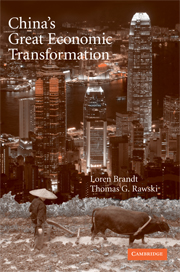Book contents
- Frontmatter
- Contents
- List of Figures
- List of Tables
- Contributors
- Acknowledgments
- Map
- 1 China's Great Economic Transformation
- 2 China and Development Economics
- 3 China in Light of the Performance of the Transition Economies
- 4 A Political Economy of China's Economic Transition
- 5 The Demographic Factor in China's Transition
- 6 The Chinese Labor Market in the Reform Era
- 7 Education in the Reform Era
- 8 Environmental Resources and Economic Growth
- 9 Science and Technology in China
- 10 The Political Economy of Private Sector Development in China
- 11 The Role of Law in China's Economic Development
- 12 China's Fiscal System: A Work in Progress
- 13 Agriculture in China's Development: Past Disappointments, Recent Successes, and Future Challenges
- 14 China's Financial System: Past, Present, and Future
- 15 China's Industrial Development
- 16 China's Embrace of Globalization
- 17 Growth and Structural Transformation in China
- 18 Income Inequality during China's Economic Transition
- 19 Spatial Dimensions of Chinese Economic Development
- 20 Forecasting China's Economic Growth to 2025
- Index
20 - Forecasting China's Economic Growth to 2025
Published online by Cambridge University Press: 24 May 2010
- Frontmatter
- Contents
- List of Figures
- List of Tables
- Contributors
- Acknowledgments
- Map
- 1 China's Great Economic Transformation
- 2 China and Development Economics
- 3 China in Light of the Performance of the Transition Economies
- 4 A Political Economy of China's Economic Transition
- 5 The Demographic Factor in China's Transition
- 6 The Chinese Labor Market in the Reform Era
- 7 Education in the Reform Era
- 8 Environmental Resources and Economic Growth
- 9 Science and Technology in China
- 10 The Political Economy of Private Sector Development in China
- 11 The Role of Law in China's Economic Development
- 12 China's Fiscal System: A Work in Progress
- 13 Agriculture in China's Development: Past Disappointments, Recent Successes, and Future Challenges
- 14 China's Financial System: Past, Present, and Future
- 15 China's Industrial Development
- 16 China's Embrace of Globalization
- 17 Growth and Structural Transformation in China
- 18 Income Inequality during China's Economic Transition
- 19 Spatial Dimensions of Chinese Economic Development
- 20 Forecasting China's Economic Growth to 2025
- Index
Summary
Why attempt to forecast China's economic growth? Most importantly, the impact of China on the rest of the world and on the standard of living of its own people depends mainly on whether the nation continues to double the size of its gross domestic product (GDP) every seven to ten years or whether that growth slows markedly or even halts. China already influences the world economy through its booming exports, its demand for natural resources, its influence on global warming, and much else. A GDP four times the current level will multiply China's worldwide impact.
But there is another reason why forecasting Chinese growth is desirable in a volume dedicated to understanding China's present and past economic performance. The ability to forecast is one important test of whether the analysis has gotten the story right. There are many ways to forecast the future, some of which, like simple projections of recent trends, tell us little about the present and not much about the future.
But analytical forecasts based on a model that attempts to sort out the main influences that are likely to shape that future can deepen our understanding of the mechanisms driving Chinese growth. Even if the forecasts are a bit off the mark or downright wrong, a good model allows analysts to review a forecast's strengths and limitations and to identify specific shortcomings that contributed to the gap between predictions and ultimate outcomes.
- Type
- Chapter
- Information
- China's Great Economic Transformation , pp. 829 - 886Publisher: Cambridge University PressPrint publication year: 2008
- 72
- Cited by



